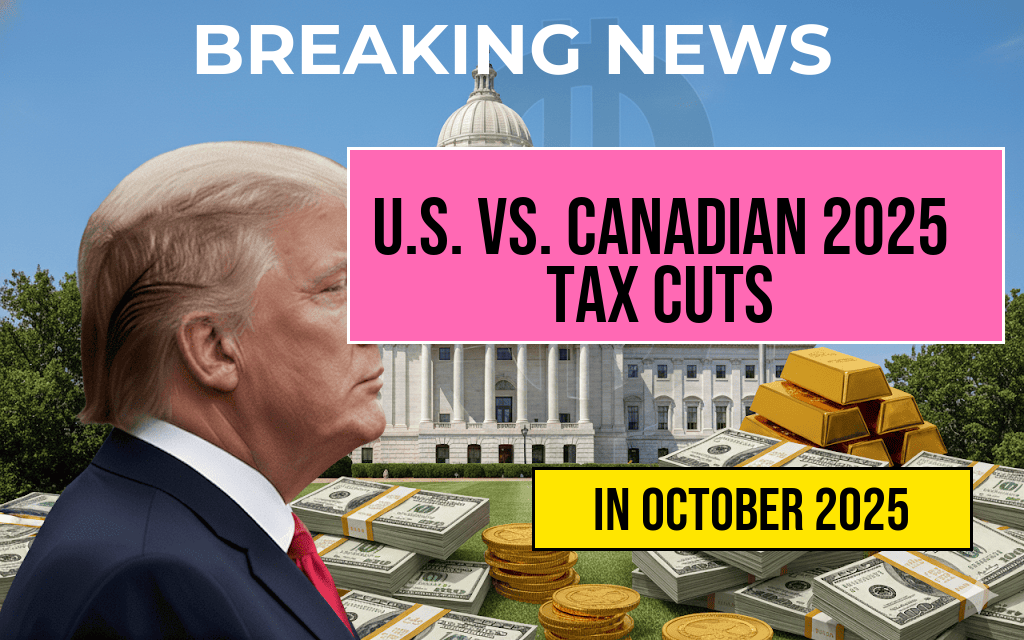As 2025 approaches, the contrasting approaches to tax relief in the United States and Canada are drawing increasing attention. Recent policy shifts have resulted in notable tax cuts, with American taxpayers receiving an average benefit of approximately $3,752, while their Canadian counterparts enjoy a tax reduction valued at around C$5,200. These figures reflect broader economic strategies aimed at stimulating growth, addressing income disparities, and adapting to shifting fiscal landscapes. Analyzing these figures through an international lens underscores the differences in tax policy philosophies, government revenue priorities, and economic conditions that shape each country’s approach to individual and corporate taxation.
Understanding the Scope of 2025 Tax Cuts
The U.S. Perspective
In the United States, recent reforms have aimed to simplify the tax code and promote economic expansion. The average $3,752 reduction primarily benefits middle-income earners, with significant adjustments made to income brackets and standard deductions. The Tax Cuts and Jobs Act of 2017 laid foundational changes, but subsequent modifications have continued to adjust the tax landscape. These reductions are expected to increase disposable income, potentially fueling consumer spending and investment. However, critics argue that such cuts may also elevate the federal deficit if not offset by spending reforms or increased revenues elsewhere.
The Canadian Approach
Canada’s tax policy in 2025 reflects a different set of priorities, emphasizing targeted relief for middle- and lower-income households. The average C$5,200 reduction stems from a combination of federal and provincial measures, including tax credits, deductions, and adjustments to personal income brackets. Canada’s progressive tax system allows for nuanced benefits, with higher earners experiencing smaller proportional cuts. This approach aims to balance fiscal responsibility with social equity, emphasizing sustainable revenue streams alongside support measures for vulnerable populations.
Comparative Analysis of Tax Relief Impact
| Aspect | United States | Canada |
|---|---|---|
| Average benefit per taxpayer | $3,752 | C$5,200 |
| Scope of relief | Middle-income focus, standard deductions | Broad, includes targeted credits for lower-income groups |
| Policy philosophy | Economic stimulus, growth-oriented | Social equity, fiscal sustainability |
| Funding mechanism | Potential deficit increase if not offset | Revenue-neutral adjustments, provincial coordination |
While the nominal figures differ—reflecting currency and economic scale—the relative impact on households aligns with each nation’s policy objectives. U.S. tax cuts tend to favor economic stimulation through broader cuts, whereas Canada emphasizes targeted fiscal support that aligns with its social welfare commitments.
Economic and Political Contexts Shaping Tax Policies
United States: Growth and Deficit Concerns
The U.S. experience with tax cuts often revolves around balancing economic growth with fiscal health. The 2025 cuts come amid debates over rising national debt and inflationary pressures. Lawmakers argue that lowering taxes spurs job creation and investment, but skeptics point to the risk of widening budget deficits and reduced funding for public services. The political landscape remains divided, with ongoing discussions about the long-term sustainability of such policies. For more on U.S. fiscal policy debates, see Tax Policy in the United States.
Canada: Social Programs and Revenue Stability
Canada’s tax strategy reflects its broader commitment to social programs and a robust public healthcare system. The 2025 tax cuts are designed to maintain revenue stability while providing relief that supports lower and middle-income Canadians. Political consensus tends to favor cautious adjustments, emphasizing fiscal responsibility and long-term sustainability. This approach aims to prevent deficits while ensuring that social safety nets remain intact, especially in light of demographic shifts and aging populations. To learn more about Canada’s fiscal policies, visit Taxation in Canada.
Implications for Taxpayers and Policymakers
The immediate benefit for taxpayers in both countries is increased disposable income, but the underlying strategies differ. U.S. taxpayers might experience more significant gains in the short term but face questions about long-term fiscal health. Canadian policymakers prioritize sustainable growth with a focus on social equity, which could influence future tax reforms. Businesses and investors monitor these shifts closely, as tax policies directly impact economic competitiveness and investment climate.
As 2025 unfolds, comparative analyses of tax relief efforts will continue to inform debates about economic policy and social priorities. Both nations grapple with balancing growth, fiscal responsibility, and social support — a challenge that reflects their distinct economic philosophies and political landscapes.
Frequently Asked Questions
What are the main differences between U.S. and Canadian tax cuts in 2025?
The main differences are the tax cut amounts and currency values. The U.S. offers a tax cut of $3,752, while Canada provides a C$5,200 tax cut, highlighting the variations in tax policy and economic strategies.
How does the international perspective influence the comparison of U.S. and Canadian tax cuts?
The international perspective allows for a broader understanding of how tax policies impact economic competitiveness and standard of living in both countries, emphasizing the relative value of the tax cuts across borders.
Why are the tax cut amounts in different currencies (USD and CAD) significant?
The differing currencies reflect the economic size and market differences between the U.S. and Canada. Comparing these amounts highlights the relative impact of tax cuts in each country’s economic context.
What factors might influence future tax cut policies in the U.S. and Canada?
Future tax policies may be influenced by economic growth, government budgets, political priorities, and international economic trends. These factors determine how tax relief is structured in each country.
How can individuals and businesses benefit from understanding these tax cuts?
Understanding the differences and impacts of U.S. and Canadian tax cuts helps individuals and businesses make informed financial decisions, optimize tax planning, and anticipate economic opportunities in each country.






